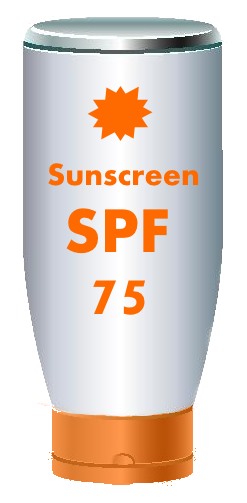Chemicals to avoid - Chemical sunscreens
Chemical Sunscreens
Primary function – Chemical filters intended to protect skin from UV damage
What to look for - Oxybenzone , Octyl-methoxycinnamate, Octocrylene, Octyl salicyclate Benzophenone, Dioxybenzone, Phenylbenzimidazole, Homosalate, 4-methyl-benzylidene camphor (4-MBC), Menthyl anthranilate, Homosalate, Dioxybenzone, Methoxycinnamate, Cinoxate, octyl-dimethyl-PABA
There’s no denying that you need to protect your skin from high levels of sun exposure. Choosing the right form of protection is important to ensure that you are not poisoning your body in an attempt to shield your skin. Topical sun protection comes in two categories – sunscreens and sunblock. Sunscreens contain chemical filters that absorb UV radiation thereby reducing sun damage. A sunblock prevents UV from hitting your skin in the first place – it provides physical protection by blocking sun. Your sunglasses, hat and clothing can be considered sun blocks. In a topical skin product, mineral sunblocks such as zinc oxide (non-nano) are considered safe. Mineral sunblocks physically shield your skin and reflect UV rays (UVA and UVB) away.
 Sunscreens however, have come under fire for the types of chemicals that they use. Oxybenzone is an active ingredient in many chemical sunscreens that enters the blood stream and mimics estrogen in the body. It can also cause allergies disrupts the endocrine system. A study conducted by the University of Zurich documented the disrupting behaviour of five chemicals commonly found in sunscreens. The effects of benzophenone-3 (Bp-3), homosalate (HMS), 4-methyl-benzylidene camphor (4-MBC), octyl-methoxycinnamate (OMC), and octyl-dimethyl-PABA (OD-PABA) were tested. These chemical filters were shown to be easily absorbed into the body and even mimicked estrogen. In addition, they also proliferated the growth of cancer cells in lab tests.
Sunscreens however, have come under fire for the types of chemicals that they use. Oxybenzone is an active ingredient in many chemical sunscreens that enters the blood stream and mimics estrogen in the body. It can also cause allergies disrupts the endocrine system. A study conducted by the University of Zurich documented the disrupting behaviour of five chemicals commonly found in sunscreens. The effects of benzophenone-3 (Bp-3), homosalate (HMS), 4-methyl-benzylidene camphor (4-MBC), octyl-methoxycinnamate (OMC), and octyl-dimethyl-PABA (OD-PABA) were tested. These chemical filters were shown to be easily absorbed into the body and even mimicked estrogen. In addition, they also proliferated the growth of cancer cells in lab tests.A study published by the University of California, Riverside shows that octyl methoxycinnamate, octocrylene, and oxybenzone in sunscreen increase free radical activity as they breakdown and get absorbed in skin, resulting in skin damage.
A guide published by the Environmental Working Group (EWG) provides a chart of chemicals found in common sunscreens listing health and skin impact.
More doctors are starting to speak out against the dangers of chemical filters in sunscreen and even recommend safe sunblocks that have minerals like Zinc oxide. A few simple steps and precautions can help reduce incidence of sun damage on your skin:
- If you’re fond of a sunscreen, read through the ingredients
- Consider using a safe sunblock and re-applying after swimming or sweating
- Wear a hat, shades and lose clothing to cover skin
- Avoid sun at peak hours - generally 12 noon to 3pm.
- Eat healthy and include anti-oxidants that fight free-radical damage
Quick Summary (Chemical Sunscreens)
Be on the lookout for (Prime offenders):
Oxybenzone , Octyl-methoxycinnamate, Octocrylene,
Octyl salicyclate Benzophenone, Dioxybenzone,
Homosalate, Dioxybenzone, octyl-dimethyl-PABA
Oxybenzone , Octyl-methoxycinnamate, Octocrylene,
Octyl salicyclate Benzophenone, Dioxybenzone,
Homosalate, Dioxybenzone, octyl-dimethyl-PABA
What makes them controversial:
High skin absorb-ability and allergy
Hormone disruption,
Toxic breakdown products
High skin absorb-ability and allergy
Hormone disruption,
Toxic breakdown products
Commonly found in:
Chemical sunscreens
Chemical sunscreens

